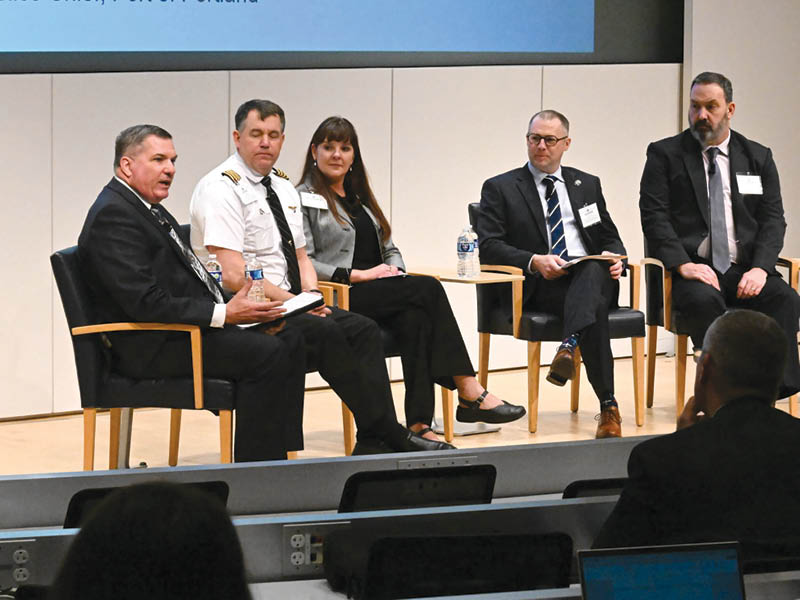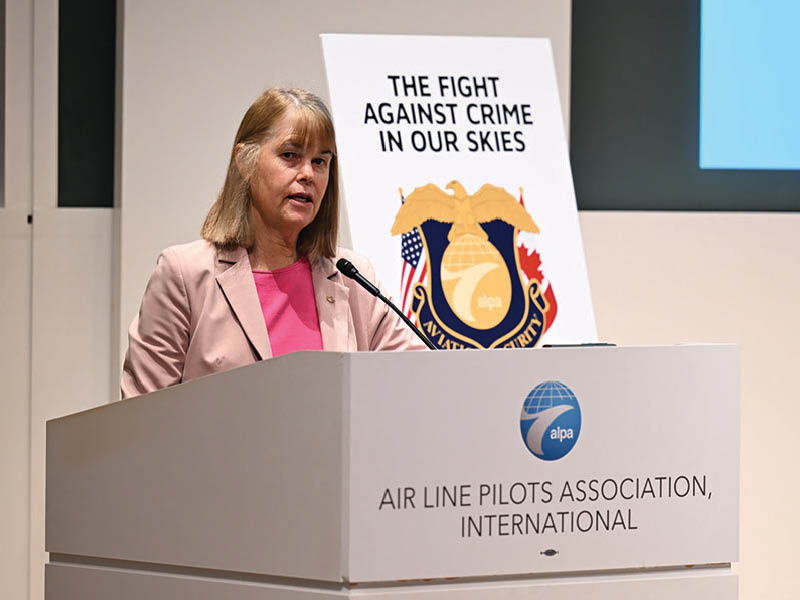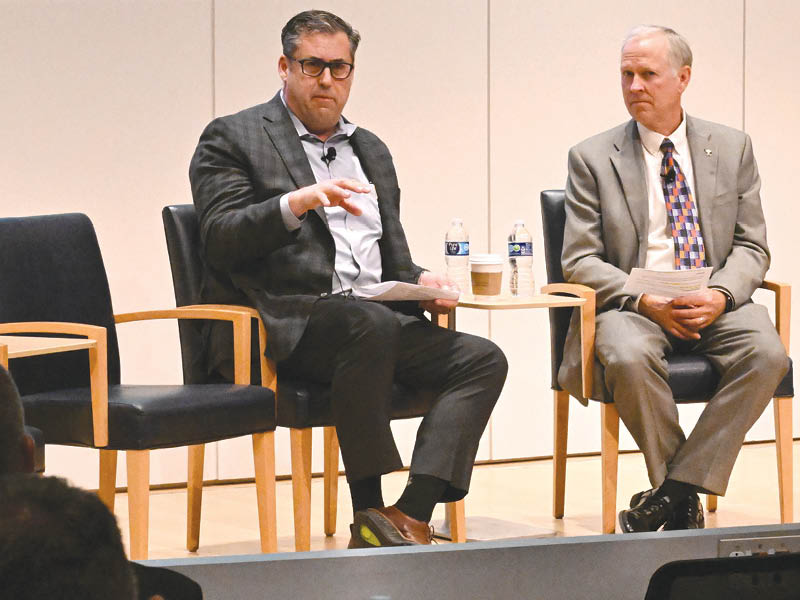Aviation Security Professionals Examine the Fight Against Crime in Our Skies
By John Perkinson, Senior Staff Writer

Capt. Darrin Dorn (Alaska), left, ALPA’s Aviation Security Group vice chair, moderates a panel discussion titled “Mental Health and In-flight Security.”
Accounts of aggressive and out-of-control passenger behavior continue to raise serious concerns about in-flight safety and security. A traveler aboard a recent Alaska Airlines flight from San Diego, Calif., to Washington, D.C., made multiple attempts to enter the aircraft’s flight deck. After a recent United Airlines flight from London, UK, to Newark, N.J., a man now owes the carrier $20,638 in restitution fees for his belligerent interactions with the cabin crew and threats to “mess up the plane,” requiring the pilots to divert the aircraft to Bangor, Me.
“Unfortunately, these types of incidents have become all too common on passenger flights, and the risk to passengers and crewmembers continues to be at an unacceptable level,” said Capt. Wendy Morse, ALPA’s first vice president and national safety coordinator, during her opening remarks at the Association’s “The Fight Against Crime in Our Skies” in-flight crimes symposium.
For the second year in a row, the ALPA symposium, held at the Association’s McLean, Va., offices on April 24–25, brought together representatives from U.S. and Canadian labor, airlines, government agencies, law enforcement, and other aviation security stakeholders to review recent trends in unruly passenger events. Through panel discussions and other presentations, the group also took a comprehensive look at ways the industry can better work together to respond to future occurrences while minimizing risks.
“As of April 14, the FAA had already received 556 reports since the beginning of the year,” Morse noted. “And every week, it seems, more such incidents are reported in the news or documented with video on various social media platforms.” Just 16 days later, the FAA announced that the incident count had climbed to 649.

Capt. Wendy Morse, ALPA’s first vice president and national safety coordinator, welcomes attendees to the Association’s in-flight crimes symposium.
International Recognition
The Tokyo Convention of 1963, also known as the Convention on Offenses and Certain Other Acts Committed on Board Aircraft, helped codify illegal air transportation activity. This treaty of the International Civil Aviation Organization (ICAO) declared it unlawful for individuals to engage in “acts which, whether or not they are offenses [against the penal law of a state], may or do jeopardize the safety of the aircraft or of persons or property therein or which jeopardize good order and discipline on board.”
The North American airline industry witnessed a significant spike in unruly passenger behavior during the COVID-19 pandemic. While the report numbers have declined in the last two years, they remain elevated as compared to prepandemic levels, demanding an industry response with more effective deterrence and mitigation strategies.
“Some days, it’s like the wild, wild west,” remarked Melissa Madden, a representative from the Association of Flight Attendants, who serves as a member of the ICAO Cabin Safety Group. Madden, who participated in a panel discussion titled “International Operations Perspectives on In-flight Crimes,” observed that cabin crews need training focused on de-escalating potentially contentious situations. Some pilots and flight attendants already engage in self-defense courses.
Alexandra Orr, manager of Corporate Security for United Airlines, noted that the average daily incident rate of in-flight disturbances at her carrier has increased significantly from that of 2023.
During another discussion, panelists talked about intoxication, substance abuse, and mental-health concerns as factors in many of the incidents they see. Several participants observed that occurrences of sexual assault have been increasing. These situations are particularly challenging for cabin crews, given the proximity of the offender—even when moved away from the victim—due to the confines of the aircraft cabin.
Capt. Darrin Dorn (Alaska), ALPA’s Air Safety Organization (ASO) Aviation Security Group vice chair, who moderated another panel, noted that in an event involving a false bomb threat, the involved airline treated the members of the flight deck crew differently than the cabin crew. “Pilots and flight attendants are sometimes separated,” he said, adding that the disparity went unnoticed until it was later identified during the debriefing.
Coordination and Response
As part of a system to manage and report instances of onboard events, ICAO has established a four-tiered scale with corresponding threat levels to help airlines, airports, and responding law enforcement better understand the significance and urgency of each encounter. These threats levels are
- Level 1—Disruptive behavior (verbal),
- Level 2—Physically abusive behavior,
- Level 3—Life-threatening behavior (or display of a weapon), and
- Level 4—Attempted or actual breach of the flight deck.
Capt. Mike Karn, senior manager of Flight Security for American Airlines, highlighted the dual role the captain plays as both pilot-in-command and senior security officer on every flight. Karn explained that American is working to standardize initial action for incidents that are Level 2 and above, implementing a “broader form of crew resource management” to get other groups involved.
James Punchard, the deputy air marshal for the Transportation Security Administration’s (TSA) Transportation Security Operations Center (TSOC), outlined how the center uses threat-level information. The TSOC works with the Department of Homeland Security, the FAA, the FBI, and other law enforcement and security agencies to monitor, assess, and coordinate security-related operations and responses.
The Airport Law Enforcement Agencies Network (ALEAN), another cooperative resource, provides an intelligence-sharing network for airport criminal investigators and assists with the development and integration of public policy related to aviation law enforcement.
Jason Wallis, police chief for the Port of Portland, Ore., and a former ALEAN president, noted that the network was created after New York and New Jersey law enforcement officials met with representatives from Interpol. They discussed the possibility of establishing an organization to foster the exchange of information concerning emerging criminal trends associated with airport operations.
Capt. Wolfgang Koch (Delta), the ASO’s Aviation Security Group chair, who shared symposium moderator duties with Dorn, asserted, “There needs to be more of this kind of collaboration to improve our processes and procedures.”
Among the deterrents discussed, Koch noted, “Now more than ever, with disruptive passengers attempting to rush the flight deck, secondary barriers are needed to keep these individuals from gaining access to the controls of the aircraft.” In June 2023, the FAA announced that secondary barriers would be mandated for new airliners. ALPA continues to press for their installation on all Part 121 aircraft in service.

Capt. Wolfgang Koch (Delta), right, ALPA’s Air Safety Organization Aviation Security Group chair, engages Capt. Mike Karn, the senior manager of Flight Safety for American Airlines, about incident reporting and trends.
In two separate presentations, conference participants heard from FBI Special Agents Daniel Markley and David Rodski. These first responders, assigned to Washington-Baltimore area airports, recounted numerous examples of recent malfeasance, including some involving law enforcement, government, and airline employee improprieties.
Rodski posed a potential scenario in which an intoxicated passenger, removed from a flight for unruly behavior, unsuccessfully attempts to immediately purchase a ticket from a different carrier. Ensuring that airport operators are made aware of disruptive activity, when it occurs, provides an additional layer of security.
Determining the Proper Authority
Jurisdiction for crimes committed on airline flights in the United States is covered by Title 49 of the U.S. Code. Federal authority generally applies as soon as the aircraft’s doors are closed. This authority continues until the doors open at the flight’s destination. Otherwise, crimes are prosecuted through the airport’s municipal or county jurisdiction.
Alexander Blanchard, the Major Crimes Unit chief for the U.S. Attorney’s Office, gave a presentation titled “Prosecution of Crimes Aboard Aircraft,” outlining the different criminal offenses for federal prosecution. They include assault, attempted murder, sexual abuse offenses, aircraft piracy, carrying a weapon or an explosive on an aircraft, interference with a flightcrew member, false information, threats, simple possession of drugs, possessions of drugs with intent to distribute, and aiming a laser pointer at an aircraft.
The FAA periodically increases civil penalties for these violations to preserve their effectiveness as deterrents, per the Federal Civil Penalties Inflation Adjustments Act Improvements Act of 2015.
In a final segment of the symposium, a panel discussed “Industry Initiatives: How Are We Reversing the Trend?” Capt. Bill Cason (UPS) from the Coalition of Airline Pilots Associations, and Chan Browne, director of Security for the Atlanta Hartsfield-Jackson International Airport, discussed their participation on the TSA’s Aviation Security Advisory Committee and some of its individual contributions to the agency’s aviation security work.
Scott Houston, senior director of the Chertoff Group, which provides strategies for aviation security risk management, acknowledged the need to revisit alcohol policies at airports, drawing special attention to the practice of airport bars giving passengers to-go cups. He talked about the importance of conducting routine audits to make sure airport businesses are using good practices.
“The threat that unruly passengers pose to flight safety and security also underscores the importance of always having at least two pilots on the flight deck,” Morse told symposium attendees. She also highlighted the tremendous success of the Federal Flight Deck Officer program in providing an additional resource to cabin crews responding to these and other irregularities.

